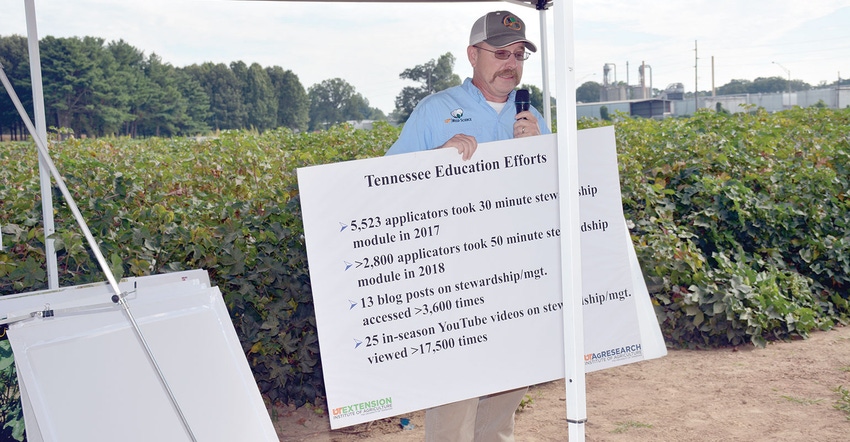
“What a difference a year makes,” said Larry Steckel, University of Tennessee weed scientist, to a cotton field day audience Wednesday at Jackson, Tenn.
The difference, he demonstrated on a cardboard sign, shows about a 50 percent drop in official complaints to the Tennessee Department of Agriculture on dicamba drift.
As of July 10, 2017, TDA had received about 70 dicamba drift calls, mostly on non-DT soybeans. Those calls included some 400,000 acres of “mostly non-DT soybeans showing some injury,��” Steckel said
In 2018, by July 10, TDA had received “about 40 dicamba drift calls, mostly on everything else. About 30,000 acres of non-DT soybeans showed some injury.”
He says about 25 percent of Tennessee’s cotton acreage is planted to Enlist this year. “Extension has run a number of off-target 2,4-D cases, but none have been reported to TDA. Not sure why not.”
He says several factors may contribute to the reduction in dicamba drift calls. Possibly, the increased acreage of tolerant varieties offered producers protection. Educational efforts beginning in 2017 also played a role.
Steckel showed another sign indicating the scope of those efforts. Some 5,523 applicators took 30-minute stewardship modules in 2017. In 2018, 2,800 applicators took 50-minute stewardship modules.
“We produced 13 blog posts on stewardship that were accessed more than 3,600 times,” Steckel says.
“We had 25 in-season YouTube videos that were viewed more than 17,500 times.”
An extra year’s experience with the technology likely played a role.
Ongoing Stewardship
The efforts must continue, Steckel says. Sensitive crops and landscapes are vulnerable and damage to these off-target plants can be costly.
“Consider that 95 percent of the state’s soybeans are Xtend. LibertyLink, Roundup Ready and conventional varieties account for about 100,000 acres. About 75 percent of the state’s cotton acreage is Xtend with 25 percent in Enlist and only a trace of LibertyLink and conventional.”
Steckel says producers grow soybeans in the Middle-Tennessee area, where much of the state’s tobacco is grown. He showed slides of curled tobacco leaves, probably the result of dicamba injury.
“These growers can lose their contracts,” he says. “This is a big issue in Kentucky, too.”
He says landscapes, especially sycamore trees, are vulnerable and have shown damage from dicamba. “Sycamore trees are probably more sensitive than soybeans.”
He says he expects to hear from EPA “any day now,” on a registration decision for the dicamba and 2, 4-D products.
“I think we will have a label, probably with a cutoff date. When that cutoff will be is a question mark. The devil will be in the details.”
About the Author(s)
You May Also Like






